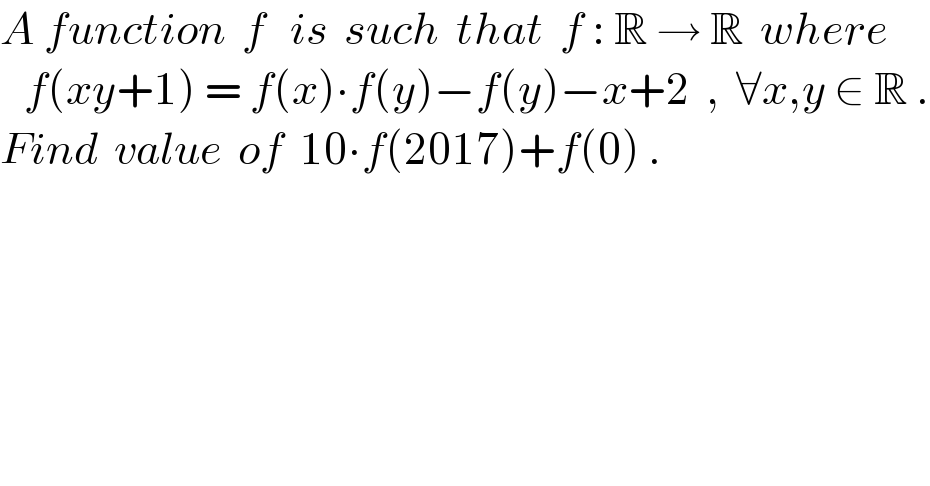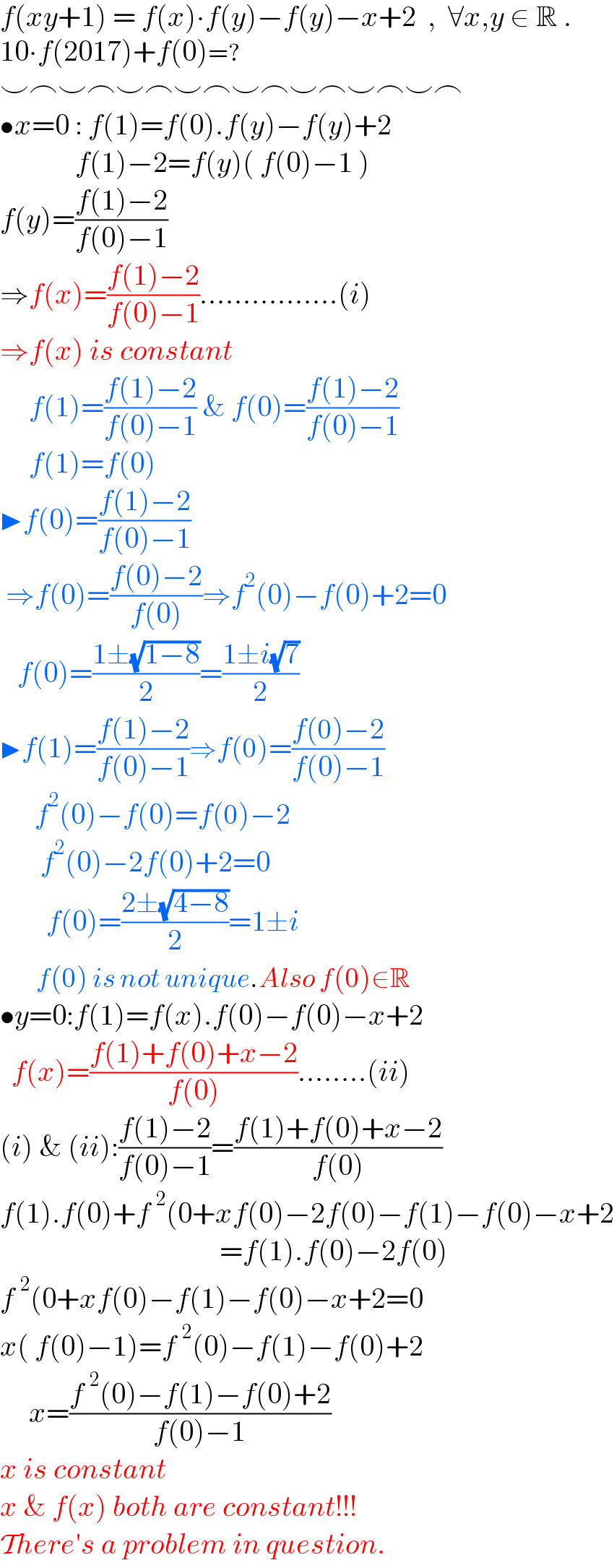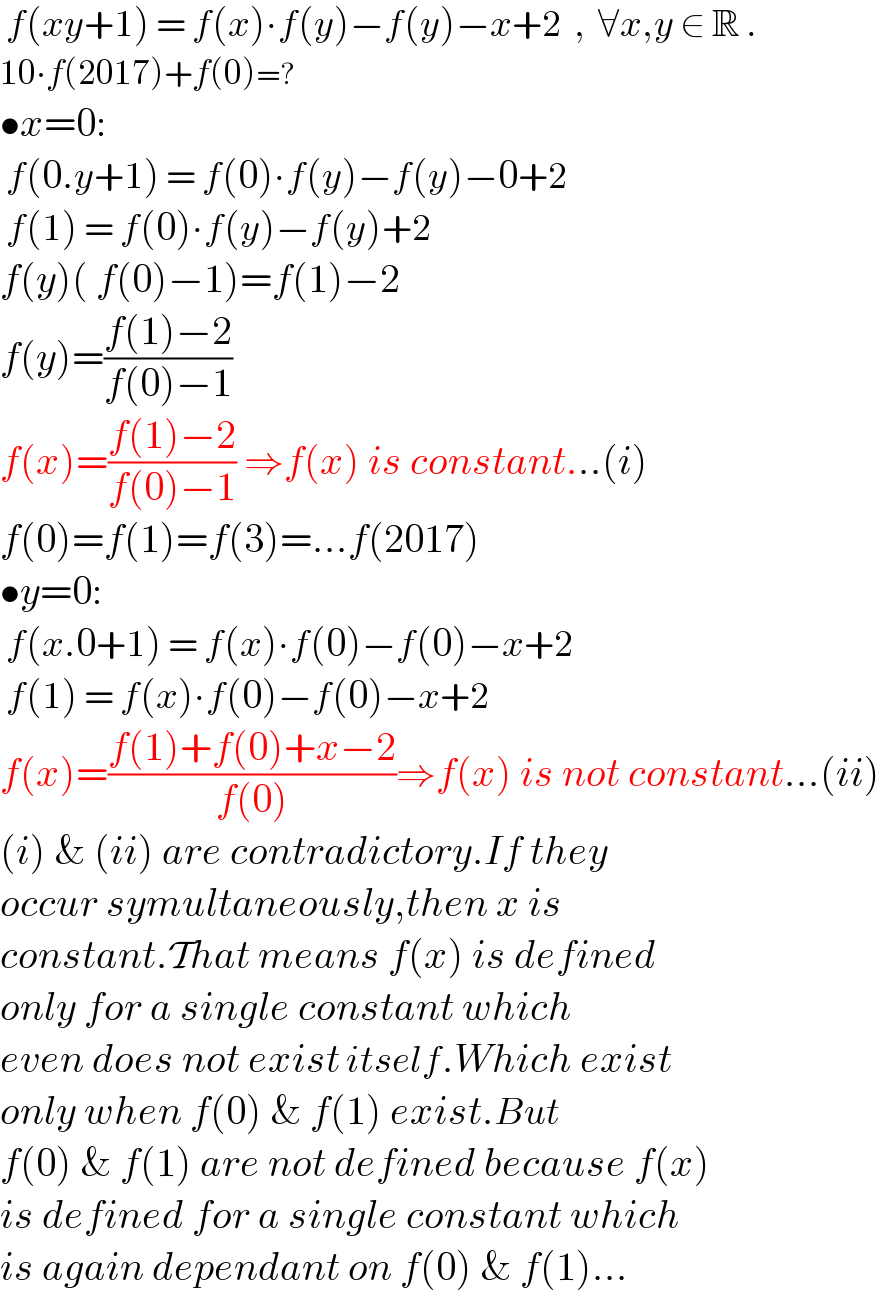
Question Number 162116 by naka3546 last updated on 26/Dec/21

$${A}\:{function}\:\:{f}\:\:\:{is}\:\:{such}\:\:{that}\:\:{f}\::\:\mathbb{R}\:\rightarrow\:\mathbb{R}\:\:{where} \\ $$$$\:\:\:{f}\left({xy}+\mathrm{1}\right)\:=\:{f}\left({x}\right)\centerdot{f}\left({y}\right)−{f}\left({y}\right)−{x}+\mathrm{2}\:\:,\:\:\forall{x},{y}\:\in\:\mathbb{R}\:. \\ $$$${Find}\:\:{value}\:\:{of}\:\:\mathrm{10}\centerdot{f}\left(\mathrm{2017}\right)+{f}\left(\mathrm{0}\right)\:. \\ $$
Answered by Rasheed.Sindhi last updated on 27/Dec/21

$${f}\left({xy}+\mathrm{1}\right)\:=\:{f}\left({x}\right)\centerdot{f}\left({y}\right)−{f}\left({y}\right)−{x}+\mathrm{2}\:\:,\:\:\forall{x},{y}\:\in\:\mathbb{R}\:. \\ $$$$\mathrm{10}\centerdot{f}\left(\mathrm{2017}\right)+{f}\left(\mathrm{0}\right)=? \\ $$$$\smile\frown\smile\frown\smile\frown\smile\frown\smile\frown\smile\frown\smile\frown\smile\frown \\ $$$$\bullet{x}=\mathrm{0}\::\:{f}\left(\mathrm{1}\right)={f}\left(\mathrm{0}\right).{f}\left({y}\right)−{f}\left({y}\right)+\mathrm{2} \\ $$$$\:\:\:\:\:\:\:\:\:\:\:\:\:{f}\left(\mathrm{1}\right)−\mathrm{2}={f}\left({y}\right)\left(\:{f}\left(\mathrm{0}\right)−\mathrm{1}\:\right) \\ $$$${f}\left({y}\right)=\frac{{f}\left(\mathrm{1}\right)−\mathrm{2}}{{f}\left(\mathrm{0}\right)−\mathrm{1}} \\ $$$$\Rightarrow{f}\left({x}\right)=\frac{{f}\left(\mathrm{1}\right)−\mathrm{2}}{{f}\left(\mathrm{0}\right)−\mathrm{1}}................\left({i}\right) \\ $$$$\Rightarrow{f}\left({x}\right)\:{is}\:{constant} \\ $$$$\:\:\:\:\:{f}\left(\mathrm{1}\right)=\frac{{f}\left(\mathrm{1}\right)−\mathrm{2}}{{f}\left(\mathrm{0}\right)−\mathrm{1}}\:\&\:{f}\left(\mathrm{0}\right)=\frac{{f}\left(\mathrm{1}\right)−\mathrm{2}}{{f}\left(\mathrm{0}\right)−\mathrm{1}} \\ $$$$\:\:\:\:\:{f}\left(\mathrm{1}\right)={f}\left(\mathrm{0}\right) \\ $$$$\blacktriangleright{f}\left(\mathrm{0}\right)=\frac{{f}\left(\mathrm{1}\right)−\mathrm{2}}{{f}\left(\mathrm{0}\right)−\mathrm{1}} \\ $$$$\:\Rightarrow{f}\left(\mathrm{0}\right)=\frac{{f}\left(\mathrm{0}\right)−\mathrm{2}}{{f}\left(\mathrm{0}\right)}\Rightarrow{f}^{\mathrm{2}} \left(\mathrm{0}\right)−{f}\left(\mathrm{0}\right)+\mathrm{2}=\mathrm{0} \\ $$$$\:\:\:{f}\left(\mathrm{0}\right)=\frac{\mathrm{1}\pm\sqrt{\mathrm{1}−\mathrm{8}}}{\mathrm{2}}=\frac{\mathrm{1}\pm{i}\sqrt{\mathrm{7}}}{\mathrm{2}} \\ $$$$\blacktriangleright{f}\left(\mathrm{1}\right)=\frac{{f}\left(\mathrm{1}\right)−\mathrm{2}}{{f}\left(\mathrm{0}\right)−\mathrm{1}}\Rightarrow{f}\left(\mathrm{0}\right)=\frac{{f}\left(\mathrm{0}\right)−\mathrm{2}}{{f}\left(\mathrm{0}\right)−\mathrm{1}} \\ $$$$\:\:\:\:\:\:{f}^{\mathrm{2}} \left(\mathrm{0}\right)−{f}\left(\mathrm{0}\right)={f}\left(\mathrm{0}\right)−\mathrm{2} \\ $$$$\:\:\:\:\:\:\:{f}^{\mathrm{2}} \left(\mathrm{0}\right)−\mathrm{2}{f}\left(\mathrm{0}\right)+\mathrm{2}=\mathrm{0} \\ $$$$\:\:\:\:\:\:\:\:{f}\left(\mathrm{0}\right)=\frac{\mathrm{2}\pm\sqrt{\mathrm{4}−\mathrm{8}}}{\mathrm{2}}=\mathrm{1}\pm{i} \\ $$$$\:\:\:\:\:\:\:\:{f}\left(\mathrm{0}\right)\:{is}\:{not}\:{unique}.{Also}\:{f}\left(\mathrm{0}\right)\notin\mathbb{R} \\ $$$$\bullet{y}=\mathrm{0}:{f}\left(\mathrm{1}\right)={f}\left({x}\right).{f}\left(\mathrm{0}\right)−{f}\left(\mathrm{0}\right)−{x}+\mathrm{2} \\ $$$$\:\:{f}\left({x}\right)=\frac{{f}\left(\mathrm{1}\right)+{f}\left(\mathrm{0}\right)+{x}−\mathrm{2}}{{f}\left(\mathrm{0}\right)}........\left({ii}\right) \\ $$$$\left({i}\right)\:\&\:\left({ii}\right):\frac{{f}\left(\mathrm{1}\right)−\mathrm{2}}{{f}\left(\mathrm{0}\right)−\mathrm{1}}=\frac{{f}\left(\mathrm{1}\right)+{f}\left(\mathrm{0}\right)+{x}−\mathrm{2}}{{f}\left(\mathrm{0}\right)} \\ $$$${f}\left(\mathrm{1}\right).{f}\left(\mathrm{0}\right)+{f}^{\:\:\mathrm{2}} \left(\mathrm{0}+{xf}\left(\mathrm{0}\right)−\mathrm{2}{f}\left(\mathrm{0}\right)−{f}\left(\mathrm{1}\right)−{f}\left(\mathrm{0}\right)−{x}+\mathrm{2}\right. \\ $$$$\:\:\:\:\:\:\:\:\:\:\:\:\:\:\:\:\:\:\:\:\:\:\:\:\:\:\:\:\:\:\:\:\:\:\:\:\:\:={f}\left(\mathrm{1}\right).{f}\left(\mathrm{0}\right)−\mathrm{2}{f}\left(\mathrm{0}\right) \\ $$$${f}^{\:\:\mathrm{2}} \left(\mathrm{0}+{xf}\left(\mathrm{0}\right)−{f}\left(\mathrm{1}\right)−{f}\left(\mathrm{0}\right)−{x}+\mathrm{2}=\mathrm{0}\right. \\ $$$${x}\left(\:{f}\left(\mathrm{0}\right)−\mathrm{1}\right)={f}^{\:\:\mathrm{2}} \left(\mathrm{0}\right)−{f}\left(\mathrm{1}\right)−{f}\left(\mathrm{0}\right)+\mathrm{2} \\ $$$$\:\:\:\:\:{x}=\frac{{f}^{\:\:\mathrm{2}} \left(\mathrm{0}\right)−{f}\left(\mathrm{1}\right)−{f}\left(\mathrm{0}\right)+\mathrm{2}}{{f}\left(\mathrm{0}\right)−\mathrm{1}} \\ $$$${x}\:{is}\:{constant} \\ $$$${x}\:\&\:{f}\left({x}\right)\:{both}\:{are}\:{constant}!!! \\ $$$$\mathcal{T}{here}'{s}\:{a}\:{problem}\:{in}\:{question}. \\ $$
Commented by naka3546 last updated on 27/Dec/21

$${Thank}\:\:{you},\:\:{sir}\:.\:{Might}\:\:{be}\:\:{the}\:\:{question}\:{is}\:\:{not}\:\:{completed}. \\ $$
Answered by Rasheed.Sindhi last updated on 27/Dec/21

$$\:{f}\left({xy}+\mathrm{1}\right)\:=\:{f}\left({x}\right)\centerdot{f}\left({y}\right)−{f}\left({y}\right)−{x}+\mathrm{2}\:\:,\:\:\forall{x},{y}\:\in\:\mathbb{R}\:. \\ $$$$\mathrm{10}\centerdot{f}\left(\mathrm{2017}\right)+{f}\left(\mathrm{0}\right)=? \\ $$$$\bullet{x}=\mathrm{0}: \\ $$$$\:{f}\left(\mathrm{0}.{y}+\mathrm{1}\right)\:=\:{f}\left(\mathrm{0}\right)\centerdot{f}\left({y}\right)−{f}\left({y}\right)−\mathrm{0}+\mathrm{2} \\ $$$$\:{f}\left(\mathrm{1}\right)\:=\:{f}\left(\mathrm{0}\right)\centerdot{f}\left({y}\right)−{f}\left({y}\right)+\mathrm{2} \\ $$$${f}\left({y}\right)\left(\:{f}\left(\mathrm{0}\right)−\mathrm{1}\right)={f}\left(\mathrm{1}\right)−\mathrm{2} \\ $$$${f}\left({y}\right)=\frac{{f}\left(\mathrm{1}\right)−\mathrm{2}}{{f}\left(\mathrm{0}\right)−\mathrm{1}} \\ $$$${f}\left({x}\right)=\frac{{f}\left(\mathrm{1}\right)−\mathrm{2}}{{f}\left(\mathrm{0}\right)−\mathrm{1}}\:\Rightarrow{f}\left({x}\right)\:{is}\:{constant}...\left({i}\right) \\ $$$${f}\left(\mathrm{0}\right)={f}\left(\mathrm{1}\right)={f}\left(\mathrm{3}\right)=...{f}\left(\mathrm{2017}\right) \\ $$$$\bullet{y}=\mathrm{0}: \\ $$$$\:{f}\left({x}.\mathrm{0}+\mathrm{1}\right)\:=\:{f}\left({x}\right)\centerdot{f}\left(\mathrm{0}\right)−{f}\left(\mathrm{0}\right)−{x}+\mathrm{2} \\ $$$$\:{f}\left(\mathrm{1}\right)\:=\:{f}\left({x}\right)\centerdot{f}\left(\mathrm{0}\right)−{f}\left(\mathrm{0}\right)−{x}+\mathrm{2} \\ $$$${f}\left({x}\right)=\frac{{f}\left(\mathrm{1}\right)+{f}\left(\mathrm{0}\right)+{x}−\mathrm{2}}{{f}\left(\mathrm{0}\right)}\Rightarrow{f}\left({x}\right)\:{is}\:{not}\:{constant}...\left({ii}\right) \\ $$$$\left({i}\right)\:\&\:\left({ii}\right)\:{are}\:{contradictory}.{If}\:{they} \\ $$$${occur}\:{symultaneously},{then}\:{x}\:{is} \\ $$$${constant}.\mathcal{T}{hat}\:{means}\:{f}\left({x}\right)\:{is}\:{defined} \\ $$$${only}\:{for}\:{a}\:{single}\:{constant}\:{which}\: \\ $$$${even}\:{does}\:{not}\:{exist}\:{itself}.{Which}\:{exist} \\ $$$${only}\:{when}\:{f}\left(\mathrm{0}\right)\:\&\:{f}\left(\mathrm{1}\right)\:{exist}.{But} \\ $$$${f}\left(\mathrm{0}\right)\:\&\:{f}\left(\mathrm{1}\right)\:{are}\:{not}\:{defined}\:{because}\:{f}\left({x}\right) \\ $$$${is}\:{defined}\:{for}\:{a}\:{single}\:{constant}\:{which} \\ $$$${is}\:{again}\:{dependant}\:{on}\:{f}\left(\mathrm{0}\right)\:\&\:{f}\left(\mathrm{1}\right)... \\ $$
Commented by mr W last updated on 28/Dec/21

$${i}\:{also}\:{think}\:{the}\:{question}\:{is}\:{wrong}\:{or} \\ $$$${not}\:{completely}\:{expressed}. \\ $$
Commented by Rasheed.Sindhi last updated on 28/Dec/21

$$\mathbb{T}\mathrm{han}\Bbbk\mathrm{s}\:\mathrm{a}\:\mathrm{lot}\:\boldsymbol{\mathrm{sir}}! \\ $$
